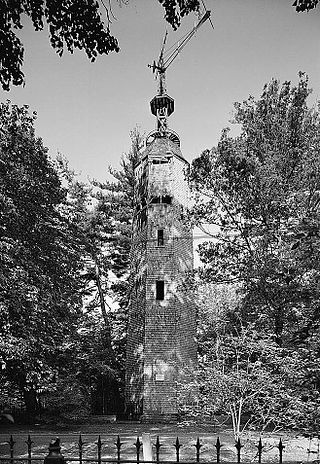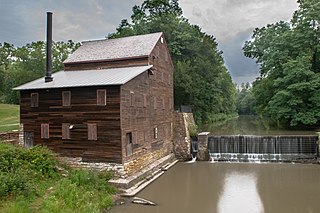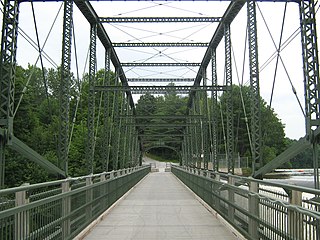
A windmill is a structure that converts wind power into rotational energy using vanes called sails or blades, by tradition specifically to mill grain (gristmills), but in some parts of the English-speaking world, the term has also been extended to encompass windpumps, wind turbines, and other applications. The term wind engine is also sometimes used to describe such devices.

Neshanic is an unincorporated community and census-designated place (CDP) located within Hillsborough Township, in Somerset County, in the U.S. state of New Jersey. It is located near the South Branch Raritan River. The Neshanic Historic District was listed on the National Register of Historic Places in 1979.

The Alameda Works Shipyard, in Alameda, California, United States, was one of the largest and best equipped shipyards in the country. The only building remaining from the yard is the Union Iron Works Powerhouse, which is listed on the National Register of Historic Places.1956.

The Fabyan Windmill is an authentic, working Dutch windmill dating from the 1850s located in Geneva, Kane County, Illinois, just north of Batavia, Illinois, off Illinois Route 25. The five-story wooden smock mill with a stage, which stands 68 feet (21 m) tall, sits upon the onetime estate of Colonel George Fabyan, but is now part of the Kane County Forest Preserve District.

Brayton Grist Mill is an historic grist mill along Mashamoquet Brook, at the entrance to Mashamoquet Brook State Park off United States Route 44 in Pomfret, Connecticut. Built about 1890, it is one of the best-preserved 19th-century rural grist mills in the state. It was listed on the National Register of Historic Places in 1986. The mill has been restored, and is maintained by the Pomfret Historical Society as the Marcy Blacksmith Museum; it is open by appointment.

The Bronson Windmill is an historic windmill at 3015 Bronson Road in Fairfield, Connecticut. Built in 1893-94, it is the only surviving windmill in the town, ouf a number that once dotted the landscape. It was built for Frederic Bronson, owner of the local estate. The mill was listed on the National Register of Historic Places in 1971.

Beebe Windmill is a historic mill located at the southeast corner of Ocean Road and Hildreth Avenue in Bridgehampton, New York.

Gladden Windmill is an historic windmill formerly located on Pigeon Valley Road in Napoli, Cattaraugus County, New York. The windmill was built in 1890 and is a well-preserved example of a vertical wind turbine built during the 19th century. Although no longer operational, the turbine is a rare example of wind power technology in the United States.

Otis Company Mill No. 1 is a historic mill on E. Main Street in Ware, Massachusetts, United States. Built in 1845, it is one of the best-preserved stone mills in western Massachusetts, and a rare surviving example of a large mill from the pre-turbine phase of industrialization. The building was listed on the National Register of Historic Places in 1982. It was further listed as a contributing property to the Ware Millyard Historic District in 1986.

Pine Creek Gristmill is a historic building located in Wildcat Den State Park in Muscatine County, Iowa, United States. The building was listed on the National Register of Historic Places in 1979.

The Nashua Manufacturing Company Historic District in Nashua, New Hampshire, is a historic district that was listed on the National Register of Historic Places (NRHP) in 1987. It encompasses an area just west of downtown Nashua, roughly located along the southern bank of the Nashua River, bordered on the west side by Mine Falls Park, on the south side by the Nashua River canal, up to Ledge Street, and from the east side by Factory, Pine and Water streets, up to the Main Street bridge.

Spring Mill is an unincorporated community in Whitemarsh Township, Montgomery County, Pennsylvania, United States.

Tinton is a ghost town in the Black Hills of Lawrence County, South Dakota, United States. Founded in 1876, it started out as a gold mining camp and later began to produce tin. It had a heavy decline in the early 20th century due to the decline in the mining industry, and the town was fully abandoned by the 1950s. Beginning in 1937, it was home to the Dakota Tin and Gold Mine, which was listed on the National Register of Historic Places in 2005.

The Page Belting Company Mills is a historic mechanical belt mill complex at 26 Commercial Street in Concord, New Hampshire, United States. Located north of Concord's central business district near Horseshoe Pond, the complex consists of four brick buildings built between 1892 and 1906 for one of the city's major businesses. The mill complex, now converted to residential and other uses, was listed on the National Register of Historic Places in 2002.

The Douglas & Jarvis Patent Parabolic Truss Iron Bridge is a historic bridge across the Missisquoi River in Highgate, Vermont. Located at the end of Mill Hill Road, it is at 215 feet (66 m) one of the longest bridges of its type in the northeastern United States. It was built in 1887, and was listed on the National Register of Historic Places in 1974.

The Joshua Twing Gristmill is a historic industrial facility at 450 North Main Street in the city of Barre, Vermont. Built in 1844, it is a remarkably high-style example of Greek Revival architecture for an essentially utilitarian industrial structure. Joshua Twing, its builder, was engaged for many years in a variety of industrial pursuits, primarily considered with engineering improvements in water wheels and turbines. The building was listed on the National Register of Historic Places in 1978.

The Oakland Mills Bridge is a historic structure located in Oakland Mills Park southwest of Mount Pleasant, Iowa, United States. The span carried Hickory Road over the Skunk River for 358 feet (109 m). In July 1876 the Henry County Board of Supervisors decided to locate the bridge over the Skunk River at Oakland Mills. After engineers looked over the proposals, they choose the Missouri Valley Bridge and Iron Company of Leavenworth, Kansas to build the structure. The long-span combination Pratt truss through and pony truss was completed later the same year. The steel components where manufactured by the Phoenix Iron Company of Pennsylvania. It is one of the oldest Pratt through truss bridges in Iowa. Long closed to vehicular traffic, it was listed on the National Register of Historic Places in 1998.

Neshanic Mills is a 5-acre (2.0 ha) historic district on the South Branch Raritan River along River Road and Mill Lane at Neshanic Station in Somerset County, New Jersey, United States. The district was added to the National Register of Historic Places on January 9, 1978, for its significance in engineering, industry, transportation, and settlement. It includes 4 contributing buildings and 2 contributing structures.




















